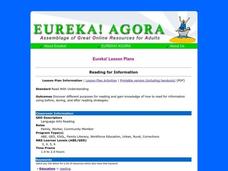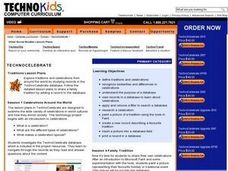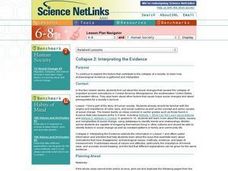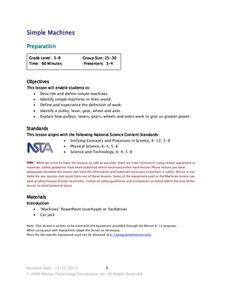Curated OER
Treasures of Egypt
Learners match pictures of Egyptian culture with their descriptions. They assemble a poster of resources about Egypt.
Curated OER
I Need More Information!
Students decide on an issue and then determine what questions they would like to have answered while researching the topic. They develop and improve their research skills by using a variety of available sources to investigate and write...
Curated OER
Reading to Calculate
Pupils examine the calculator. For this math lesson, students use the directions to learn how to use a calculator. Pupils apply the knowledge and solve problems using the calculator.
Curated OER
Reading the Newspaper
Learners explore how to find needed information about community events, resources, and employment. Students identify headlines, datelines, and sections of the newspaper. They participate in a newspaper treasure hunt. Learners read and...
Curated OER
Child Safety Brochure
Learners explore child safety information and use this information to produce a child safety brochure. During this process, they will have a chance to gather, organize, summarize and write information about child safety.
Curated OER
Living Longer
Students relate health information text to themselves and society. In this health information lesson, students answer questions using the 5 W's based on the health issue they are reading about. Students discuss life changes they might...
Curated OER
How to Study for a Test
Students discuss and write about how to study for a test and create a class test taking manual. They can also choose to write GED questions to become more familiar with test questions.
Curated OER
Letter Writing Basics
Students construct a letter about a classroom issue as a class. They then write a letter individually that requests information, file a complaint or complement, or write a letter to the editor/legislator.
Curated OER
Reading a Local and National Weather Map
Students practice reading a national and local weather map. Using this information, they work together to make predictions about the weather for the next few days. They discuss the use of symbols and maps as a class and discuss how...
Curated OER
Reading for Information
Students explore different strategies for reading with a purpose utilizing information before, during and after reading selections. They find out about a topic of interest and then find a text that contains that interest and analyze that...
Curated OER
Details, Details, Details
Students add details to their writing. In this language arts lesson, students use details to enhance their writing. Students view a picture and write a paragraph about what they see. Students conference with another student to edit their...
Curated OER
Help! I Need Five Minutes to Study
Students learn to use a time grid or a calendar to increase productivity of their studying. In this studying lesson, students record how they spend their studying time and then adjust as needed. Students recognize various ways to...
National Endowment for the Humanities
Using Historic Digital Newspapers for National History Day
Your learners will take a trip through history as they peruse through historic digitalized newspapers, reading real articles from such historical periods in the United States as the Temperance movement and passage of the Thirteenth...
Curated OER
Techno Celebrate
Students explore world traditions by utilizing computer programs. In this Internet research lesson, students utilize the TechnoCelebrate digital database to locate information regarding cultural celebrations. Students utilize Microsoft...
Curated OER
The Price of Beauty: What you don't know might hurt you
Learners study cosmetic safety issues and concerns raised by advocacy groups. They create a cosmetic safety brochure designed for the average consumer, to create awareness about cosmetic safety concerns.
Curated OER
Introduction of Primary Sources
First graders create two personal artifacts to add to a primary source shoebox that represents information about themselves. The first draw a self-portrait then build an artifact from Play-Doh and pipe cleaners to represent something...
Alabama Learning Exchange
Is My Water Safe?
Learners discuss what makes their drinking water safe and unsafe. They locate and visit a local tributary and test the water's pH, hardness, dissolved oxygen, and total alkalinity. They compose a summary paragraph about the tests and...
Curated OER
Slave Narratives
Students use a database to find and read examples of slave narratives. In groups, they read the various narratives and discuss their feelings about them. They also research the time period in which the narratives were written to end...
Curated OER
Writers and the Old South Myth
Students are introduced to authors of the South. In groups, they compare and contrast the pastoral and counter pastoral traditions present in some forms of Southern literature. They use a database to examine the covers of the books...
Curated OER
Dialect Poems of Paul Laurence Dunbar
Pupils examine the life and works of Paul Laurance Dunbar. In groups, they read various poems of his and use a database to examine the covers of his books. They also discuss the criticism he faced during his life and how he dealt with...
Curated OER
Science NetLinks: Collapse 2: Interpreting the Evidence
Students continue to explore the factors that contribute to the collapse of a society; they also explore how archaeological evidence is gathered and interpreted. Students explore about the social changes that caused the collapse of...
Curated OER
Botanical Discoveries
Sixth graders study the chronology of major events of the Lewis and Clark Expedition. They use primary and secondary resources to obtain information about the plants which were identified by Lewis and Clark.
Curated OER
Look Ma! I'm a Rocket Scientist!
Students use a ball to push and pull to demonstrate the concept of force. In this force lesson plan, students talk about the importance of force in space and use balls to demonstrate this phenomena.
Curated OER
Simple Machines
Fourth graders choose a simple machine and write about they way they believe it will work. Students experiment, write down procedures used and record observations. They will find a picture of the machine and add it to their report.

























